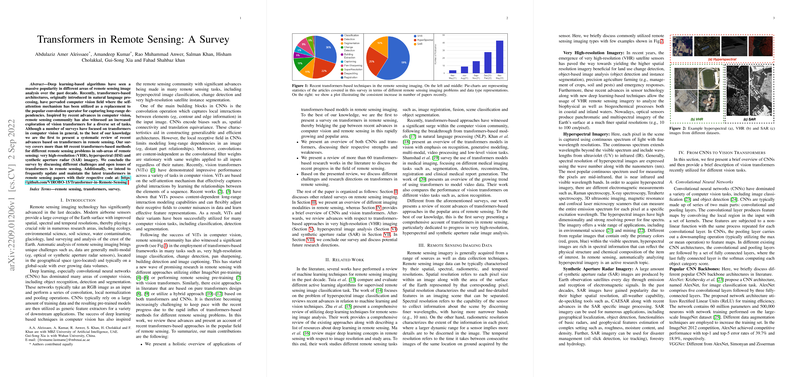Transformers in Remote Sensing: A Survey
The paper, "Transformers in Remote Sensing: A Survey," offers an extensive examination of the utilization of transformers within the scope of remote sensing. It systematically reviews the adoption and adaptation of transformer-based architectures, originally developed for natural language processing tasks, to solve various challenges within the domain of remote sensing imagery. Remote sensing encompasses a wide range of applications, from environmental monitoring to urban planning, and the adoption of deep learning, particularly transformers, represents a significant development in processing the massive volumes of multi-modal and geographically diverse data.
Survey Scope and Categorization
This survey covers over 60 transformers-based methods, dissected into three principal sub-areas of remote sensing: Very High-Resolution (VHR) imagery, Hyperspectral Imaging (HSI), and Synthetic Aperture Radar (SAR) imagery. Each sub-area presents specific challenges and opportunities for the application of transformer models, addressing tasks like scene classification, object detection, change detection, and image segmentation.
Methodological Insights
The survey emphasizes the dramatic shift in remote sensing practice driven by the self-attention mechanism of transformers, which contrasts with the traditional dependency on convolution operations. This shift allows for enhanced handling of long-range dependencies in imaging data, which is especially beneficial in tasks that involve understanding global spatial contexts and relationships within an image scene, an intrinsic limitation of convolutional neural networks that have dominated this field until now.
- VHR Imagery applications of transformers are mainly in scene classification and object detection. The results demonstrate a consistent improvement in accuracy with pre-trained transformer models, such as the hybrid CNN-transformers approaches, which leverage both global and local feature information.
- Hyperspectral Imaging (HSI) tasks benefit from transformers in the form of advanced spectral-spatial feature tokenization and multimodal data fusion. The survey underscores SpectralFormer and related models, illustrating their ability to improve classification performance by capturing complex spectral patterns.
- SAR Imagery illustrates another frontier where transformers are making significant inroads, especially for segmentation, detection, and despeckling applications. The survey highlights the potential of transformers to improve classification accuracy, aided by their capacity to reduce noise, such as speckle effects in the SAR data.
Empirical Assessment and Limitations
A substantial portion of the paper is dedicated to empirical analysis, benchmarking transformer-based remote sensing methods across various datasets. For instance, the paper rigorously evaluates classification performance on datasets like AID and object detection on DOTA. Each method is critically analyzed for its methodological strengths and across several dimensions, including model complexity and data dependency.
One primary conclusion is the substantial role that pre-training plays when using transformer architectures in remote sensing. However, the survey also identifies a significant gap in the availability of large-scale, curated datasets that are essential for pre-training transformer models in this domain. Another notable limitation is the increased computational overhead associated with transformers due to their reliance on dense self-attention mechanisms.
Future Directions and Research Challenges
The paper casts an eye towards the future, pointing out several promising research directions that could further harness the potential of transformers:
- Self-Supervised Pre-Training: As the remote sensing domain contains vast amounts of unlabeled data, self-supervised learning paradigms offer a promising avenue for pre-training transformer models without the need for extensive labeled datasets.
- Efficient Architectures: There is a need for the development of more computationally efficient transformers that retain performance while being suitable for real-time applications in resource-constrained settings.
- Hybrid Architectures: Continued exploration of CNN-transformer hybrid models could provide the ideal compromise between computational efficiency and learning capability, especially for tasks requiring fine-grained feature localization and recognition.
- Domain-Specific Adaptations: Developing transformer models tailored specifically for remote sensing challenges could yield significant performance gains over generic implementations.
- Adversarial Resilience: Investigating the robustness of transformer models against adversarial attacks and domain shifts in remote sensing is critical for deploying these models in security-sensitive applications.
In conclusion, this survey meticulously encapsulates the transformative impact of transformers on remote sensing, highlighting the advantages they offer while thoughtfully addressing the existing research gaps and challenges within the field. It serves as a valuable resource for researchers who are navigating the burgeoning integration of advanced AI methodologies in remote sensing applications.
